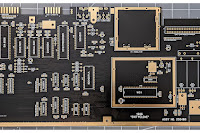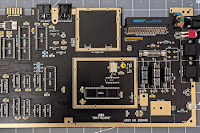Identify and Source Components
In Parts 1 and 2 of this madness, I decided I was going to design and build an RF Modulator Replacement for my SixtyClone. You should definitely read all that before reading this. And please remember, this is absolutely NOT a tutorial! Just the wild speculations of someone with very little clue what he is doing.
I finished Part 2 with a new schematic, having cut all the bits I don't need from the original:
I wasn't expecting that at all. My soldering skills just will not extend to soldering these. I'm looking for a standard through hole diode so on a hunch I looked back at the service manual, not at the schematic I have been using to date (#251696) but at the older schematic (#251025) and that indicates that the diodes undertaking the same function (referenced as D2 and D3 there) are 1SS119 diodes. If I search for that in Digikey, bingo! These are available, so long as I buy a minimum of 2,929 of them. I shit you not. So obviously thats not happening but I discovered from this that I'm looking for a "high speed switching diode" so searching that exact term provides me with an alternative, 1S2076S7A, which has almost identical specifications and is available in a minimum quantity of 8,795. Good grief.
At this point I just Googled "1SS119 replacement" and found some forums where vague references were made to the 1N4148 diode being used in place of the ISS119. I also found this page, which contained the following:
Comparing specs sheets was hopeless as they really are quite different but I figured I'm not building a rocket here and nobody's life depends on this. So with a wing and a prayer and my fingers crossed they're not too different, I added 1N4148 for parts D1 and D2.
There is very little entertainment to be had from my relating how I went through the rest of this list. I basically repeated the exact process detailed above with all of the Diodes and Transistors till I finished up with an alternative list that has more than a good chance of being mostly garbage.
At this point I decided to create a list on Digikey as I decided that was where I was going to buy everything (except the transistors which I could only source on Ebay), for no other reason than they seemed to have more in stock than Mouser.
With the more complex components dealt with, time to move on to the "easier" stuff.
The search for Capacitors was reasonably straightforward - the values are all present in the schematic and unless otherwise indicated, I assumed I needed ceramic. The only thing I needed to watch out for was the voltage rating (I got 50v) and lead spacing, i.e. the distance between the legs as this will be important when we come to design the new PCB. They are all 5mm. There is one electrolytic capacitor at C25 and I just sourced a small 330µF radial capacitor and guessed that a 25 volt rating would be sufficient.
It was a similar story for the Resistors, but here I am going to try both Carbon and Metal Film resistors, just to see if either one makes any difference at all. As it's not specified, I have guessed that I need ¼ watt resistors because that is what populated the majority of the 250466 board, but I have absolutely nothing else to go on, and the original schematics don't advise.
In a potentially embarrassing attempt to get to grips with some of the voltages on this board, I did some more Googling. I very quickly established that our Power Circuit is the well recognised Transistor Series Voltage Regulator.
You can see from the above diagram that I've simply taken our existing schematic, cropped out everything except the Power Circuit and shortened the ground wire to make it visible. I've also added 3 labels:
VOUT = Voltage Out
VBE = Base-Emitter Voltage
VZ = Zener Voltage
If I'm understanding the principle correctly (big if!) then this circuit takes the unregulated 9v input and by using the unique properties of the Zener Diode, creates a reduced, and regulated output voltage. It seems that calculating the Voltage Out in our circuit is a simple formula:
VOUT = VBE - VZ
To obtain the values for VZ and VBE I needed to consult the data sheets for the Zener Diode and Transistor I chose (1N4582A-1 and 2SC2120 respectively). If I am reading them correctly, then the VZ is 6.4V and the VBE is 0.5V (min) to 0.8V (max) which gives us a VOUT of between 5.6V to 5.9V. As the transistor is the one specified by Commodore, and the Zener diode has very similar values to those originally specified by Commodore I can only hope that this is in the ballpark of what they intended! We can attempt to test this later.
In a similar vague manner, when it comes to the two inductors at L1 and L2, the schematics do tell me I need a 22µH inductor at L1 and a 10µH inductor at L2. The only other thing we can glean from the schematic is from the symbol:










